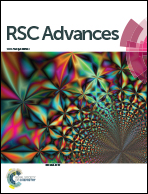Effects of representative quantum dots on microorganisms and phytoplankton: a comparative study
Abstract
With the increasing application of semiconductor particles, especially metal-based quantum dots and carbon quantum dots (CQDs), these quantum dots will inevitably be released into the environment, and therefore their effects on biota should be assessed. Few studies on the effects of CQDs on microorganisms and phytoplankton have been performed. In this paper, we put forward more effective and convenient approaches to prepare three kinds of high-quality CQDs. Then we assessed their effects on Staphylococcus aureus and Microcystis aeruginosa, which were representative of microorganisms and phytoplankton, respectively, and compared the effects with the effects of metal-based QDs (CdSe-QDs or CdTe-QDs). The results showed that CQDs at low concentrations (<50 mg L−1) had insignificant effects on the growth of Staphylococcus aureus and Microcystis aeruginosa, while the influence of the CQDs was observed significantly when the concentration was increased up to 100 mg L−1. However, the negative impact of metal-based QDs was observed at any given concentration. In conclusion, the results demonstrated that any kind of carbon quantum dot has lower ecological risks than metal-based QDs, which may provide a reference for utilizing carbon quantum dots better and safely.


 Please wait while we load your content...
Please wait while we load your content...